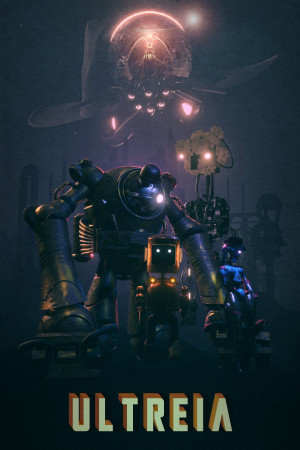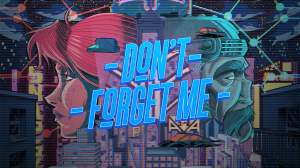Review for Ultreïa

As the future of AI and the nature of machine intelligence become increasingly relevant topics of discussion, it makes sense to wonder what a world run by machines would be like. And, much more ominously: what if we were no longer in the picture at all—what if it wasn’t just run by machines, but entirely for them as well? That’s the world of Ultreïa, where organic life is a distant memory and robots are left to live, love and work in the civilization that remains. The look we get is intriguing, and its myriad mechanical inhabitants are realized in impressively imaginative ways, but that’s not enough to distract from problematic puzzle integration, an underexplored setting, and a story that rushes to get to its largely unearned ending.
The game begins with a young robot called Nymo standing over the grave of his murdered father and swearing to avenge him. As he does so, a mysterious voice speaks in his head and advises him instead to make a pilgrimage from his unnamed homeworld to the nearby planet of Ultreïa, where he might learn the secrets of life and death. All that’s known about this mysterious world is that it holds answers to the great questions, and that only one robot—the legendary Alabtor the Great—ever traveled there and returned. Nonetheless, the voice promises that the journey there will also lead Nymo to the murderer he seeks. Intrigued by this strange presence and its apparent knowledge of the cosmos, Nymo agrees to undertake the voyage to faraway Mount St-Troy, where a method of interplanetary travel is rumored to exist.
Players control Nymo using a simple mouse-based control scheme. Clicking on a hotspot brings up icons for actions you can take—examine, pick up, use, etc.—which you then select with a second click. Conversations play out using dialogue trees that are usually short, with only two or three options. They’re also more complicated than they need to be, as lines you’ve previously chosen aren’t removed or marked once you’ve selected them, so one can easily repeat a whole dialogue branch without meaning to. A dedicated button opens your inventory, where you can examine items you’ve picked up and combine them if need be; dragging them out into the main screen allows you to use them in the environment. Another button highlights available hotspots on screen, which proved not only useful but necessary, as an unfortunate number of puzzles involve pixel hunting.
A few extra functions pop up during certain puzzles. One brief sequence allows you to switch between Nymo and another character, with an icon appearing in the upper left corner to toggle back and forth. You’ll also find yourself in a casino at one point, where you can play an entertaining card-battle mini-game whose controls involve clicking to select the card you wish to play. It’s straightforward and fun, and explains its rules effectively, but strangely for the amount of work that appears to have gone into designing it, it’s entirely optional and easily missed.
Puzzles are mostly inventory-based, and while most are intuitive and I never ran into one that felt unfair or sloppily designed, there are major issues with the way they’re implemented. The best adventure game puzzles feel like essential pieces of the story, allowing you to fully occupy the role of a character as you try to overcome their challenges; in Ultreïa, though, they mostly feel like artificial obstacles plopped into the game for their own sake. Why, for instance, does Nymo immediately agree to steal a cache of drugs for someone he just met for the promise of a cash reward when the game hasn’t presented anything he might need it for? There’s no obvious answer except that a puzzle had to show up right around then.
Another issue is the relative dearth of things to interact with on even the busiest-looking screens. With few exceptions, a hotspot’s presence is a surefire giveaway that you’ll have to interact with it to progress. Whether or not you can intuit an object’s relevance, it’s often quite easy to brute-force puzzles by using everything on everything. It’s clear, when trapped on one side of a chasm with only three or four hotspots, that the solution must involve the glowing button in the distance; there’s nothing to indicate what it does, but it’s there, so something will surely happen. Design choices like this make solving a puzzle feel less like an achievement and more like a matter of playing the odds.
Ultreïa features impressively rendered and animated 3D models and smooth pre-rendered backgrounds, along with several cutscenes. The various robot denizens sport an array of creative and surprising designs, largely foregoing the sleek humanoid silhouettes of classic science fiction and instead embracing the potential of a setting where one’s ability to look how one pleases is limited only by access to spare parts. Some bots have animalian characteristics, like a hoggish bartender or a cephalopodic gun nut; others have more functional anatomies, like a chef with a unicycle in place of legs or a tribe of winged hooligans. You’ll meet machine people in a whole range of sizes, from the huge, hulking musician Glover to tiny Bally, with the shape and stature of an ambulatory potato.
There’s a lot of Grim Fandango in Ultreïa’s visual DNA (or...wiring, I guess), which the game acknowledges via several overt references. Its boxy 3D characters with their mostly-static features stand and move in ways that evoke the LucasArts classic’s skeletal cast, and the city of Mount St-Troy—with its neon-soaked buildings, dingy drinking establishments and shady gambling dens—seems a spiritual descendant of Rubacava. Still, the resemblance, while clear, never feels like shallow homage or empty imitation; rather, Ultreïa seems to have taken inspiration from a few key places and then, adopting its influential predecessor’s freewheeling, anything-goes approach to character design and scenery, gone off in its own direction. Despite a few places where the robot models don’t blend smoothly with the background, the results are almost uniformly excellent.
The same, unfortunately, can’t be said about Ultreïa’s approach to worldbuilding and characterization. Despite hints at a shared religion and some information about the quasi-mythical status organic life holds here, the world lacks a clear sense of identity. Mount St-Troy is the only city whose name we hear, and we learn almost nothing about its history or significance; we don’t even know if there are other cities out there in the wider world, or what robot society at large is actually like. The gorgeous imagery and the endless variety of robot designs made me want to learn more about what it’s like to live in this place—what it’s like to be a robot, and what they do when they aren’t on quests to avenge their parents—but for the most part Ultreïa treats its setting as simply the stage you move through to get from puzzle to puzzle.
The characters get equally short shrift, which is a particular problem for a game that’s trying to be about love, honor and obligation. There are a good number of people to talk to, but I’d be hard-pressed to describe any of them without referencing their appearance or the puzzle they’re part of. Indeed, they come into the story when puzzles require them to be there and leave almost immediately once they’ve fulfilled their function.
Nymo himself winds up being more or less a cipher; he’s motivated by revenge, and he sometimes argues philosophical points with the calm, logical voice in his head, but I never got a sense of the actual character I was supposed to be inhabiting. This is worsened by the way so many puzzles are presented as random tasks performed for bystanders without obvious relevance to his personal mission. Rather than seeming focused on his goals and doing what he needs to see them through, he simply takes on whatever busywork a near-stranger presents him with because...well, it’s an adventure game, I guess.
Voice acting could have gone a long way toward ameliorating this problem—a lot can be conveyed about a character in the way they speak—but all dialogue is delivered in unvoiced text. This is accompanied by various beeps, blats and hisses, with the types of noises someone makes corresponding more or less to their physical appearance (a clanking rumble for the massive Glover, a seductive purr for a robot brothel’s concierge, etc.). While this helps a bit, it’s a poor substitute for the real thing in a game with such otherwise-high production values. It’s especially surprising because the sound design is quite comprehensive, and the jazzy instrumental score is evocative and used effectively.
I’d argue that the game could have been both improved and extended without adding too many additional characters, locations or puzzles; as is, its chronic underwriting leaves Ultreïa quite short, lasting just over three hours. If conversations featured more dialogue options, with more details to flesh out the world and characters, the game would probably have been a richer and more immersive experience, and a larger number of hotspots could have lent both the puzzles and the environment a greater depth and complexity. The way things stand, though, Ultreïa seems in a rush to get over its own finish line.
Nowhere is this more evident than in its ending, which came totally unexpectedly at a moment that felt, to me, like the midpoint of the second act. The finale simply arrives, and brings with it a sudden “twist” that’s meant to cast what came before in a new light. The problem is that the game gives itself no space to foreshadow this development, so that when it comes it just feels bizarre and unearned. A good twist ending works by playing on details that seemed unimportant at first glance, but which take on a special significance in retrospect. There’s none of that here; as written it feels like a surprise reveal just for the sake of having one, and it ends the game on a sour and unfulfilling note.
Conceptually, Ultreïa does many things right. Its characters and setting are unique, its world is beautiful to look at, and its puzzles are mostly intuitive, if a bit too easy to stumble through. However, for all its stylistic flourishes there’s not a lot of substance on display, and on finishing the game I realized most of the details that stuck with me were things I saw, rather than things I did or experienced. With deeper gameplay, voiced dialogue, and more space for its writing to breathe, Ultreïa might have developed into something more satisfying. Instead, it’s settled for its status as a well-visualized but otherwise disappointing game.



_capsule_fog__medium.png)























